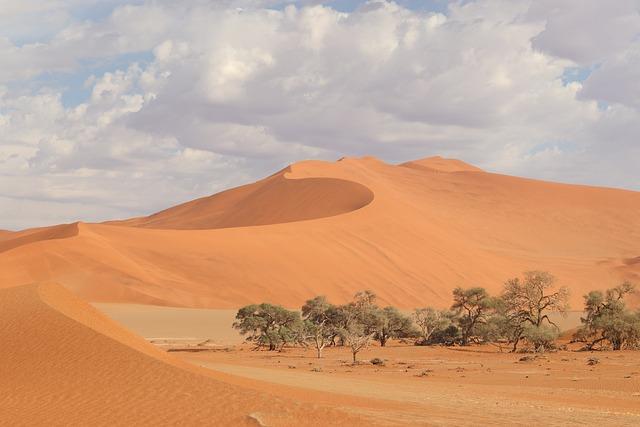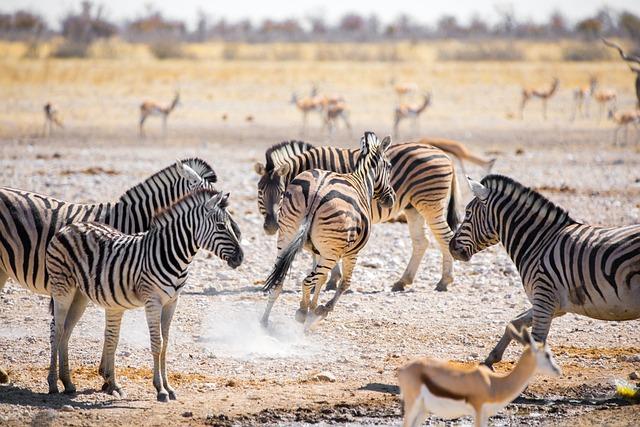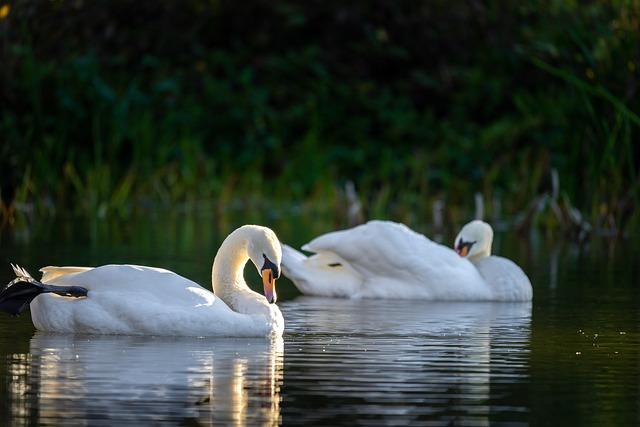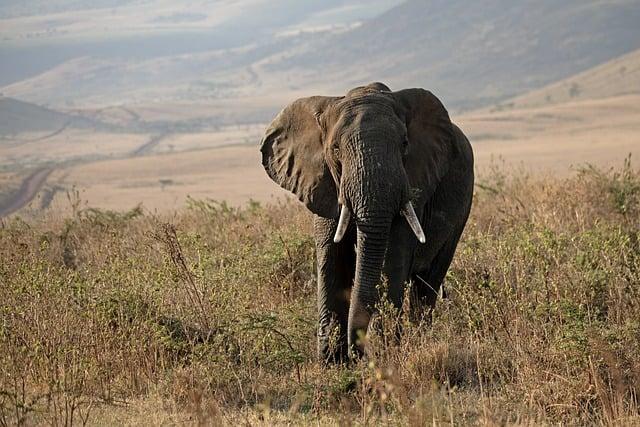In a debatable transfer that has sparked well-liked debate, Namibia has introduced plans to cull 723 wild animals, together with zebras, hippos, and a staggering 83 elephants, as a part of a broader technique to handle meals safety and organize flora and fauna populations. This resolution comes amidst growing challenges reminiscent of drought, overpopulation in sure areas, and the urgent want to make stronger native communities via lasting meals assets. Whilst proponents argue that the cull is necesary for ecological stability and the well-being of rural populations, critics lift issues in regards to the moral implications and long-term affects on flora and fauna conservation. As Namibia navigates this complicated intersection of human wishes and environmental stewardship, this text delves into the motivations in the back of the culling initiative, the doable penalties for each flora and fauna and communities, and the wider geopolitical context surrounding such flora and fauna control practices.
namibia’s Debatable Culling Plan and Its Implications for Natural world Conservation
The new declaration from Namibia to cull 723 wild animals,together with zebras,hippos,and 83 elephants,has ignited a fierce debate amongst conservationists,flora and fauna advocates,and policymakers. Supporters of the culling argue that it’s important to handle ecological stability and keep watch over overpopulation in spaces experiencing habitat degradation and useful resource festival. They declare that the culling will supply crucial meals assets for the native communities and give a contribution to the rustic’s financial system. Regardless that, detractors spotlight the moral implications and long-term penalties of such drastic measures, wondering whether or not culling is certainly probably the greatest resolution for sustainable flora and fauna control.
The results of this culling plan prolong past rapid ecological issues, affecting tourism, biodiversity, and Namibia’s recognition at the international level. Many flora and fauna fanatics and organizations are urging for selection methods that center of attention on conservation schooling, ecotourism, and sustainable habitat control.As Namibia grapples with its resolution, the combat between conservation and human pursuits raises an important questions on the way forward for no longer most effective Namibia’s flora and fauna however additionally the sophisticated stability between human building and ecological preservation. Key issues of rivalry come with:
- Moral concerns: Is taking lives the suitable method?
- Financial affects: Will preliminary financial advantages outweigh long-term losses in tourism?
- Ecological penalties: What are the prospective dangers to biodiversity and ecosystem well being?

Working out the Financial Motivations At the back of Namibia’s Choice to Cull Wild Animals
The verdict through Namibia to cull a notable choice of wild animals will also be traced to a number of financial motivations that stability conservation wishes with group welfare. The govt is basically desirous about a number of key sides that underscore this debatable but strategically thought to be motion:
- Useful resource Control: Through managing flora and fauna populations, Namibia goals to handle ecological stability whilst making sure that assets such as grazing land and water stay sustainable for each flora and fauna and farm animals.
- Meals Safety: The culling is a part of a broader initiative to handle meals shortage in rural communities, the place meat can turn into a very important supply of diet. This method without delay helps native populations through offering inexpensive protein assets.
- Financial Incentives: Income generated from the sale of culled meat will also be reinvested into conservation systems, reaping benefits each flora and fauna and human populations. This is expected to mitigate human-wildlife war,as group individuals see rapid monetary returns.
The implementation of such culling practices, even though, isn’t with out controversy and poses moral questions.Stakeholders are divided at the sustainability and morality of killing wholesome animals, resulting in discussions round selection answers.As a notable instance, organising managed searching or eco-tourism may provide extra humane method of managing flora and fauna populations whilst nonetheless contributing significantly to Namibia’s financial system. Right here’s a temporary evaluate of doable choices:
| Selection Approach | Possible Advantages |
|---|---|
| Managed Searching | regulated source of revenue for communities and flora and fauna inhabitants control. |
| Eco-Tourism | Greater income via flora and fauna viewing that promotes conservation. |
| Reserves and Sanctuaries | Preservation of biodiversity whilst producing habitat conservation price range. |

Affect on Biodiversity and Ecosystem Well being Because of Mass Culling in Namibia
The verdict to cull an important quantity of untamed animals in Namibia raises critical issues relating to biodiversity and the whole well being of ecosystems. The focused species, together with zebras, hippos, and elephants, play an important roles in keeping up ecological stability. For example, elephants are important for woodland regeneration, whilst hippos assist form riverine landscapes. The removing of those species may end up in disruption of meals webs, lack of habitat, and a decline in species that rely on those animals for survival. Such an motion might also cause a cascade of ecological adjustments, negatively impacting no longer simply flora and fauna but in addition the human populations that depend on those ecosystems for thier livelihoods.
Additionally, culling disrupts the herbal variety processes, probably resulting in an larger incidence of sure species over others. This can lead to homogenization of flora and fauna populations, making ecosystems extra liable to illnesses and environmental adjustments. Conservationists are in particular alarmed on the prospect of dropping genetic range inside those populations, which is very important for resilience in opposition to local weather alternate and different threats. Additionally, the moral implications of large-scale culling spotlight a troubling fail to remember for the interconnectivity of species and the desire for sustainable control practices that prioritize the long-term well being of each biodiversity and ecosystem services and products.

Exploring Possible choices to Culling: Sustainable Answers for Namibia’s Natural world Control
Namibia is dealing with a vital problem in flora and fauna control, balancing the wishes of its rising inhabitants with the preservation of its distinctive ecosystems. Culling, whilst regularly noticed as a right away means of inhabitants keep watch over, raises moral and long-term sustainability questions. To deal with those issues, quite a lot of selection methods were proposed that target coexistence somewhat than removal. Tasks reminiscent of community-based conservation, translocation efforts, and fertility control are being explored as viable choices to handle flora and fauna populations with out resorting to deadly measures.
Imposing those choices may give a contribution to a extra sustainable type of useful resource control. Neighborhood engagement is an important; when native populations are concerned in flora and fauna stewardship, the inducement to give protection to animals will increase. For example, eco-tourism can function each an financial boon and a conservation technique, permitting communities to get advantages financially from holding flora and fauna. In a similar way, relocation systems can without a doubt assist organize overpopulated species with out harming them, whilst contraceptive strategies can stabilize animal numbers. Underneath is a comparability of those sustainable approaches:
| Approach | Advantages | Demanding situations |
|---|---|---|
| Neighborhood-Based totally Conservation | Empowers locals, will increase consciousness | Wishes robust organizational make stronger |
| Translocation | Reduces native overpopulation | Should ensure that habitat compatibility |
| Fertility Regulate | Humane inhabitants control | Calls for ongoing tracking |

Animal Welfare Considerations within the Context of Namibia’s Deliberate Culling Technique
The deliberate culling technique in Namibia raises vital animal welfare issues,in particular given the varied species concerned on this debatable initiative. Critics argue that killing a wide selection of flora and fauna, together with zebras, hippos, and elephants, no longer most effective poses moral dilemmas but in addition disrupts the ecological stability. Those species play important roles of their ecosystems, and their aid may result in accidental penalties reminiscent of adjustments in plants dynamics and lack of biodiversity. Moreover, the strategies proposed for culling name into query the humane remedy of those animals. Many organizations recommend for non-lethal choices that prioritize flora and fauna conservation and ecosystem well being,somewhat than resorting to large-scale killings.
Along with moral concerns,the effectiveness of any such culling technique merits scrutiny. Whilst proponents might argue that it serves a objective in inhabitants keep watch over, research counsel that culling can regularly be counterproductive. For example, when animal populations are lowered precipitously, it may end up in upper delivery charges in the last people, ensuing in rebound inhabitants will increase. This cycle can create a perpetual want for culling, elevating questions in regards to the long-term sustainability of such practices. It can be crucial to discover and construct make stronger for selection strategies, reminiscent of habitat control and community-led conservation efforts, to handle the basis reasons of wildlife-human war. The well-being of Namibia’s flora and fauna and the integrity of its herbal ecosystems rely on making knowledgeable and compassionate choices relating to animal control.

Suggestions for Balancing Human Wishes with Natural world Conservation Efforts in Namibia
To verify a sustainable coexistence between human communities and flora and fauna in Namibia, it’s crucial to undertake methods that prioritize each ecological integrity and native livelihoods. Key suggestions come with:
- Neighborhood Engagement: Contain native communities in conservation making plans and decision-making to foster a way of possession over flora and fauna assets.
- Eco-Tourism Building: Advertise eco-tourism as a viable financial selection, providing locals alternatives to have the benefit of flora and fauna with out depleting assets.
- Training and Consciousness: Enforce instructional systems that building up consciousness in regards to the ecological advantages of holding flora and fauna and supply coaching for sustainable practices.
- Sustainable Searching Rules: Identify strict tips round searching that stability meals safety with conservation objectives, making sure a sustainable inhabitants of each flora and fauna and communities.
Together with the aforementioned tips, a powerful tracking device will have to be advanced to evaluate the affect of conservation efforts on each flora and fauna populations and native communities. Possible answers come with:
- flora and fauna Corridors: create secure migration routes for flora and fauna that reduce human-wildlife war and advertise biodiversity.
- Reimbursement Systems: Enforce reimbursement schemes for farmers and communities suffering from flora and fauna,decreasing the weight on their livelihoods.
- Analysis Partnerships: Collaborate with universities and conservation organizations to make stronger analysis on flora and fauna populations and habitat well being, making sure adaptive control practices according to actual knowledge.

Final Remarks
Namibia’s resolution to cull 723 wild animals, together with iconic species reminiscent of zebras, hippos, and an important choice of elephants, has stirred a posh debate surrounding flora and fauna control and meals safety. Whilst the federal government argues that this initiative is very important for keeping up ecological stability and offering sustenance to native communities, it raises urgent questions on conservation, biodiversity, and the moral implications of culling such majestic creatures. As Namibia navigates those difficult waters,the international community watches closely,weighing the need of such movements in opposition to the long-term well being of its distinctive ecosystems. The result of this plan will most probably have lasting implications,no longer just for Namibia’s flora and fauna but in addition for the broader discourse on sustainable coexistence between human wishes and the flora and fauna. The dialog continues,spotlighting the want for cutting edge answers that recognize each flora and fauna and native livelihoods.
Source link : https://afric.news/2025/03/15/namibia-plans-to-kill-723-wild-animals-including-zebras-hippos-and-even-83-elephants-for-food-the-economic-times/
Writer : William Inexperienced
Post date : 2025-03-15 17:11:00
Copyright for syndicated content material belongs to the connected Source.



